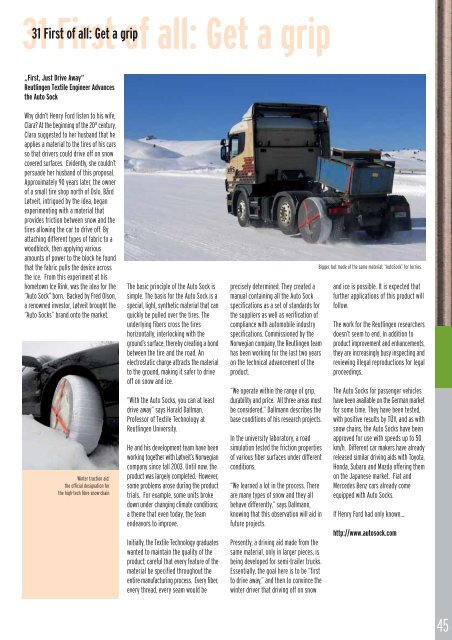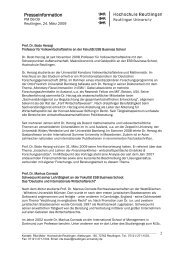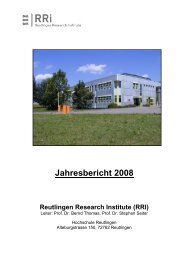Campus - Reutlingen - University - Magazine - Hochschule ...
Campus - Reutlingen - University - Magazine - Hochschule ...
Campus - Reutlingen - University - Magazine - Hochschule ...
Erfolgreiche ePaper selbst erstellen
Machen Sie aus Ihren PDF Publikationen ein blätterbares Flipbook mit unserer einzigartigen Google optimierten e-Paper Software.
31 First of all: Get a grip<br />
31 First of all: Get a grip<br />
„First, Just Drive Away“<br />
<strong>Reutlingen</strong> Textile Engineer Advances<br />
the Auto Sock<br />
Why didn’t Henry Ford listen to his wife,<br />
Clara? At the beginning of the 20 th century,<br />
Clara suggested to her husband that he<br />
applies a material to the tires of his cars<br />
so that drivers could drive off on snow<br />
covered surfaces. Evidently, she couldn’t<br />
persuade her husband of this proposal.<br />
Approximately 90 years later, the owner<br />
of a small tire shop north of Oslo, Bård<br />
Løtveit, intrigued by the idea, began<br />
experimenting with a material that<br />
provides friction between snow and the<br />
tires allowing the car to drive off. By<br />
attaching different types of fabric to a<br />
woodblock, then applying various<br />
amounts of power to the block he found<br />
that the fabric pulls the device across<br />
the ice. From this experiment at his<br />
hometown Ice Rink, was the idea for the<br />
“Auto Sock” born. Backed by Fred Olson,<br />
a renowned investor, Løtveit brought the<br />
“Auto Socks” brand onto the market.<br />
Winter traction aid:<br />
the official designation for<br />
the high-tech fibre snow-chain<br />
The basic principle of the Auto Sock is<br />
simple. The basis for the Auto Sock is a<br />
special, light, synthetic material that can<br />
quickly be pulled over the tires. The<br />
underlying fibers cross the tires<br />
horizontally, interlocking with the<br />
ground’s surface, thereby creating a bond<br />
between the tire and the road. An<br />
electrostatic charge attracts the material<br />
to the ground, making it safer to drive<br />
off on snow and ice.<br />
“With the Auto Socks, you can at least<br />
drive away” says Harald Dallman,<br />
Professor of Textile Technology at<br />
<strong>Reutlingen</strong> <strong>University</strong>.<br />
He and his development team have been<br />
working together with Løtveit’s Norwegian<br />
company since fall 2003. Until now, the<br />
product was largely completed. However,<br />
some problems arose during the product<br />
trials. For example, some units broke<br />
down under changing climate conditions;<br />
a theme that even today, the team<br />
endeavors to improve.<br />
Initially, the Textile Technology graduates<br />
wanted to maintain the quality of the<br />
product; careful that every feature of the<br />
material be specified throughout the<br />
entire manufacturing process. Every fiber,<br />
every thread, every seam would be<br />
precisely determined. They created a<br />
manual containing all the Auto Sock<br />
specifications as a set of standards for<br />
the suppliers as well as verification of<br />
compliance with automobile industry<br />
specifications. Commissioned by the<br />
Norwegian company, the <strong>Reutlingen</strong> team<br />
has been working for the last two years<br />
on the technical advancement of the<br />
product.<br />
“We operate within the range of grip,<br />
durability and price. All three areas must<br />
be considered,” Dallmann describes the<br />
base conditions of his research projects.<br />
In the university laboratory, a road<br />
simulation tested the friction properties<br />
of various fiber surfaces under different<br />
conditions.<br />
“We learned a lot in the process. There<br />
are many types of snow and they all<br />
behave differently,” says Dallmann,<br />
knowing that this observation will aid in<br />
future projects.<br />
Presently, a driving aid made from the<br />
same material, only in larger pieces, is<br />
being developed for semi-trailer trucks.<br />
Essentially, the goal here is to be “first<br />
to drive away,” and then to convince the<br />
winter driver that driving off on snow<br />
Bigger, but made of the same material: “AutoSock” for lorries.<br />
and ice is possible. It is expected that<br />
further applications of this product will<br />
follow.<br />
The work for the <strong>Reutlingen</strong> researchers<br />
doesn’t seem to end. In addition to<br />
product improvement and enhancements,<br />
they are increasingly busy inspecting and<br />
reviewing illegal reproductions for legal<br />
proceedings.<br />
The Auto Socks for passenger vehicles<br />
have been available on the German market<br />
for some time. They have been tested,<br />
with positive results by TÜV, and as with<br />
snow chains, the Auto Socks have been<br />
approved for use with speeds up to 50<br />
km/h. Different car makers have already<br />
released similar driving aids with Toyota,<br />
Honda, Subaru and Mazda offering them<br />
on the Japanese market. Fiat and<br />
Mercedes Benz cars already come<br />
equipped with Auto Socks.<br />
If Henry Ford had only known…<br />
http://www.autosock.com<br />
45






